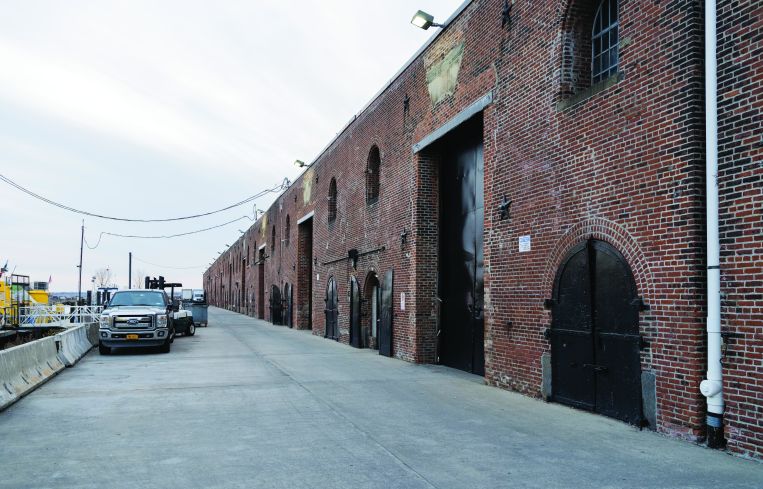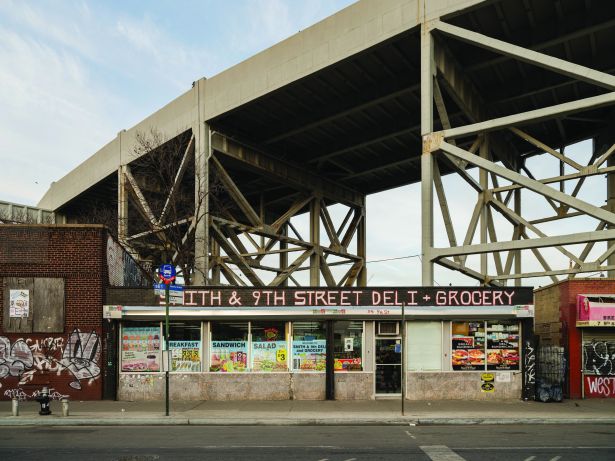Changing New York City’s Industrial Zoning? Good Luck.
Mayor Eric Adams wants to preserve manufacturing jobs and still satisfy demand for warehouse space
By Aaron Short January 25, 2022 8:45 am
reprints
In his second week as mayor, Eric Adams visited the floor of Astoria, Queens’ Steinway Factory to tout the city’s resiliency amid another coronavirus surge and the piano business’ commitment to providing high-paying jobs.
Wearing safety goggles, the mayor noted how many Steinway employees dedicated years of their lives to making the resplendent grand pianos known the world over as workers in facemasks cut metal pipes and large slabs of wood while he spoke.
“This factory really is a symbol of our strength. COVID can’t stop it,” Adams said. “When you speak with everyday men and women, some here for 35 to 40 years, you hear their stories of coming to New York and having this good union job to raise their family.”
The Queens factory provided a classic backdrop for Adams to promote in-person work and signify that preserving blue-collar jobs remained a core value of his new administration. But some fundamental shifts in New York’s economy underway well before Adams took office could seriously stymie this effort.
In particular, the city’s industrial zonings patchwork challenges any mayor to preserve the pockets of manufacturing that remain while servicing the seemingly insatiable demand for delivery warehouse space and even the needs of nightlife venues increasingly pushed to the fringes of neighborhoods.
The New York region has lost roughly half its manufacturing jobs since 1999, as companies chased cheaper labor in the South and overseas while profit margins thinned. The Bloomberg administration established industrial business zones (IBZ) in 2006 to try to protect the remaining manufacturing in certain areas.
In the meantime, land values soared as mixed-use developments, office complexes and entertainment venues encroached into these areas and replaced former factory buildings. By 2008, the city had lost 15 percent of its land zoned for manufacturing use.
Now the city is transitioning from a service-based economy to an on-demand economy where people purchase everything online and expect their packages the next day. As a result, the transportation and warehousing sector of manufacturing has steadily grown.
Once the pandemic began, the on-demand economy went into overdrive. New Yorkers came to rely on global e-commerce behemoths like Amazon and United Parcel Service for necessities while they were quarantined and new start-ups promised to deliver groceries within 15 minutes.
Demand for industrial space in the city, which had been booming over the previous three years, surged in 2021 as e-commerce companies shopping for new distribution hubs dried up warehouse inventory and drove up prices. Average rents rose 16 percent between fourth-quarter 2020 and fourth-quarter 2021 while total sales volumes exceeded $1.2 billion, according to a 2021 report from commercial real estate company JLL. The brokerage estimated at the start of 2021 that New York City could need 30 million to 40 million square feet of industrial space in as little as three years.
The prevalence of more distribution centers has also foisted more delivery vehicles onto city streets, contributing to probably the worst traffic congestion in the nation. And these distribution facilities often create fewer jobs at lower wages than the unionized factories they can replace.
Like his predecessors, Adams will almost certainly be confronted with new zoning proposals in industrial neighborhoods. But he will have to find ways to balance the preservation of high-paying manufacturing jobs and safe streets with consumers’ expectations in order to keep his vision of a city swaggering through the 21st century.
“The administration is going to need to take a hard look at where it is appropriate for these large facilities to locate and how they might be restricted by zoning, while also understanding New Yorkers increasingly want to shop online,” said Sulin Carling, principal at HR&A Advisors and a former senior economic development planner at the Department of City Planning. “Given his administration’s focus on economic recovery, it will be interesting to see how Adams balances priorities of housing versus job growth in any rezonings of industrial districts.”
Adams named former Upper East Side City Councilmember Dan Garodnick his new City Planning commissioner and is expected to tap New York Building Congress CEO Carlo Scissura to run the city’s Economic Development Corporation. If Adams wants to get a fast start on industrial policy he can start by picking up rezoning proposals nearly completed by his predecessor.
One plan would splice the 1,066-acre North Brooklyn industrial business zone (IBZ) into subregions limited to heavy manufacturing uses with taller buildings allowed, the promotion of tech-related businesses, or allow for a mix of office spaces and stores, loft living and light manufacturing. The framework reflects the needs of community advocates and industrial stakeholders and went through environmental reviews so it could be certified quickly, officials said.
“I’m hopeful we can revive an updated version of that plan in the near future,” Greenpoint Councilmember Lincoln Restler said. “We need to think about how to preserve the critical jobs and uses that are happening in our IBZs and free up limitations for unintended uses that are not what we envisioned for these areas.”
The Adams administration can also look to replicate the successes Bill de Blasio achieved in passing the Gowanus and SoHo/ NoHo rezonings late last year while avoiding his pratfalls. The Gowanus plan in particular succeeded because the city listened to community leaders who demanded $200 million to make repairs within two public housing complexes and more flexibility for parking and loading requirements. (Adams supported the Gowanus plan as Brooklyn borough president.)
Other neighborhoods with swaths of industrial space could be in line for updates. Parts of Manhattan’s Meatpacking District and Madison Square Park and Long Island City, Queens, contain manufacturing zones close to mixed-use developments. And city planners may want another crack at Brooklyn’s Bushwick, Manhattan’s Inwood and the South Bronx after de Blasio’s efforts in those places sputtered.
“There are appropriate areas for manufacturing and zoning but there are neighborhoods that continue to be zoned for manufacturing that have little to no industrial activity,” Mitchell Korbey, partner and chair of the land use practice at Herrick Feinstein, said. “We need to consider their growth and build affordable housing, and a way to do that is to consider rezoning.”
But Brooklyn Borough President Antonio Reynoso believes the city must not cede industrially zoned land, the footprint of which has been shrinking for decades, to developers eyeing inexpensive lots for their market-rate projects.
“A city that is well-planned doesn’t have a bunch of people trying to change its zoning,” Reynoso said. “We’ve let developers who want to do rezonings try to dictate what the city looks like. We need a comprehensive plan.”
As long as New Yorkers desire same-day delivery, or close to it, for their packages, logistics companies will continue to cluster in manufacturing districts, where warehouse leases are cheaper and located near freeways.
“New York City absolutely needs industrial-zoned land that works for last-mile distribution if it wants to be able to provide what every resident now expects with deliveries,” said Aaron Malitzky, executive vice president at DH Property Holdings, which operates industrial warehouses. “It is not possible, based on congestion, to really satisfy same-day delivery from New Jersey or Long Island; there need to be warehouses inside the boroughs.”
But there are measures the city can take to ensure these distribution centers don’t crowd out existing manufacturers or clog up adjacent streets.
Current zoning rules limit warehouse uses to manufacturing zones. But one approach real estate leaders have floated would be for the city to allow more distribution hubs in commercial districts, perhaps in empty storefronts or garages or even vertical warehouses for non-manufacturing uses.
“The city would want to cap the size on a commercial street in a residential area, but it makes a lot of sense to put them in an empty store if the retail space is available and there’s demand,” James Power, a land use partner at Kramer Levin, said.
Making sure goods arrive at their final destination safely is another matter. Lobbies filled up with boxes during the pandemic, overburdening doormen and spawning porch pirates. Some logistics companies have been leasing parking garages and other buildings to serve as makeshift post offices while UPS has lockers at gas stations and grocery stores for customers to pick up their packages on their own time.

“No matter what you’re doing, all of it needs storage and right now the only place you can do that is industrial districts,” said Moses Gates, vice president of housing and neighborhood planning at Regional Plan Association, a transit- and planning-focused nonprofit. “The ability to do more last-mile storage in those areas would ease that pressure on industrial areas.”
The most harmful consequence of the on-demand economy is the explosive growth of delivery vehicles that double-park on residential streets, cause fatal accidents, pollute the air and contribute to outerborough gridlock.
“We don’t want delivery by trucks or vans in some cases, we want it by bicycles and other modes,” Jay Neveloff, a partner at Kramer Levin, said. “The smart money in the industrial warehouse space is looking at these trends and trying to anticipate it.”
Adams vigorously promoted the city’s manufacturers as well as the city’s vibrant nightlife industry before he was even sworn in. Soon he may find himself drawn into an increasingly contentious relationship between them.
Nightclubs, bars and concert halls have moved into the outskirts of industrial zones in recent years, as local community boards have discouraged them from opening venues in residential neighborhoods.
The pandemic temporarily halted much of the nightlife, leading to a detente, but this past summer business owners had to sweep up after late-night parties or keep ravers from wandering into factories that were running 24/7.
“Right before Christmas there was a big event, and one patron followed a truck into a recycling facility and tried to jump on the pile of recycling that the machine was actively sorting,” said Leah Archibald, executive director of Evergreen Exchange, an advocacy group for North Brooklyn businesses. “They managed to turn the conveyer off before he was harmed.”
Balancing the needs of manufacturing and nightlife is a challenging problem, especially as club operators continue to chase affordable warehouse space deeper in the outer boroughs, where heavy industry has operated for years.
“It’s dangerous to have folks coming out of these places around big trucks moving in and out of manufacturing districts,” Brooklyn Borough President Reynoso said. “A lot of clubs are popping up and we’re not planning for them. We want people to have fun but this is a planning issue. We’re hoping whatever the problem is, we can solve it with good planning.”



